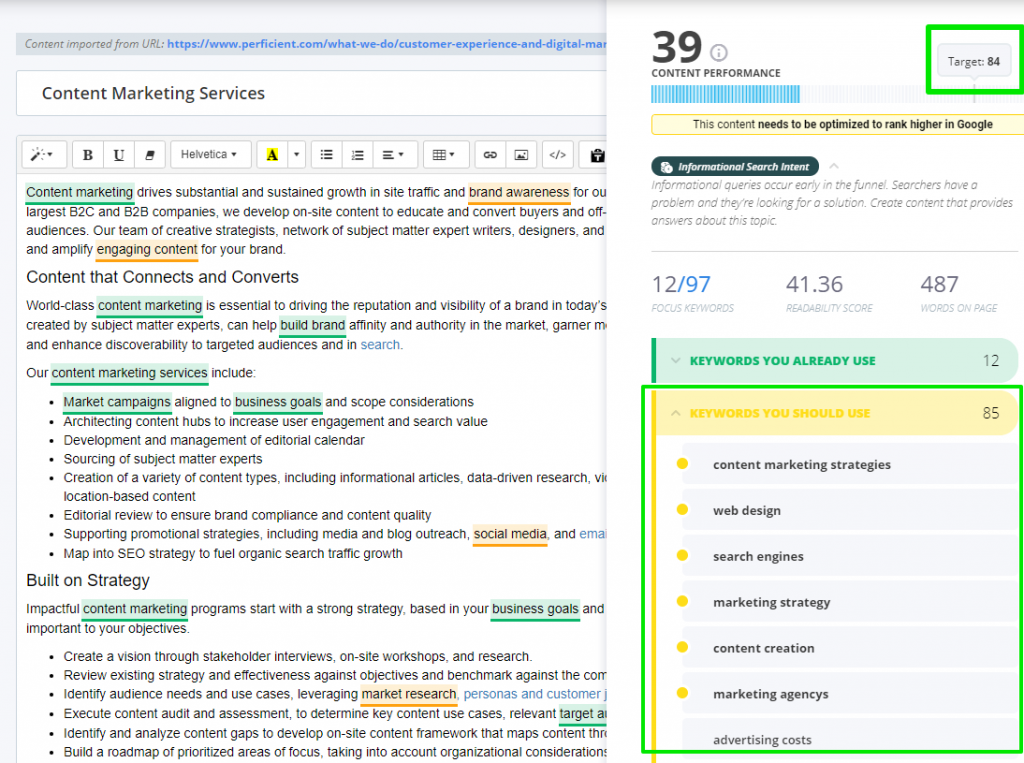As your online business grows, it becomes obvious how important content marketing is for your business. And even if you’re the one working on your business’ strategy or you hire an agency to help you out, one thing is clear: you need to know the full list of content marketing services your company needs.


Before saying that you don’t need to bother with this because you will hire a specialized digital agency to take care of all this, take this scenario: You get a great offer for a freelance or an agency, saying that they will take care of everything content related for you. That sounds appealing, yet, how can you hire them if you don’t know what they are supposed to deliver? Once you know what a complete list of content marketing services looks like, you’ll be able to set expectations, measure the efforts of the company you hired, and better understand the results.
So, here are the top content marketing services business owners should be aware of:
- Content Marketing Strategy
- Content Creation
- Content Distribution
- Constant Content Update
- Content Analytics Reporting
Content Marketing Strategy
A good content marketing strategy should respond to the question why.
Why do you want to create content? For whom? Why will your content be different than what already exists?
Content marketing strategy means more than a content strategy. This last one is focused more on content creation, which we are going to talk about later.
First thing first, you need to clarify what do you want to achieve with content marketing: Increased traffic? More leads? Educate customers? Increase online presence?
If you’ve been watching the trends lately, you’ve seen articles piling up about content marketing and how it’s changing the SEO game forever.
It seems that Google is dead set on providing visitors with pages that have the most relevant content to their search and the trend of creating quality content to be more relevant to your target audience seems to become more of a need than a game played only by the cool kids.
More and more SEO professionals are boarding this train and it’s no longer to be believed a hype and a way to reinvent the so-called “dead SEO”.
Once you got the “why” question responded, you can go to the next step within any content marketing strategy, the keyword research. You don’t want to write just for the sake of writing, right?
You want to create good content that will reach your audience. But to do so, you need to know what topics to tackle and what keywords you can create content for. So, check out the next steps, which are foundation stones for all the other content marketing services.
Use Keyword Research Tools
Finding keywords shouldn’t be hard, yet it’s not a walk in the park either. In the modern SEO landscape, a keyword research tool is not just a passing trend but a must.
The Keyword Tool and Content Optimizer is an awesome helper on this matter. It’s like your best buddy you can call in the middle of the night to get you out of trouble. You can find new topic ideas and keywords related to the one you are targeting.
You’ll be able to make an idea of how difficult it is to rank for those particular keywords. It also shows you how relevant other keywords are compared to the current ones.
When you perform the market research, it’s best if the keywords you’re trying to rank for have a high search volume and a low difficulty. High search volume means the phrase is popular and many people are typing it in their browsers. Low content and links difficulty means that it is fairly easy to rank on that keyword without many links or highly competitive content. Combining these three metrics will result in profitable phrases that are easy to rank for.
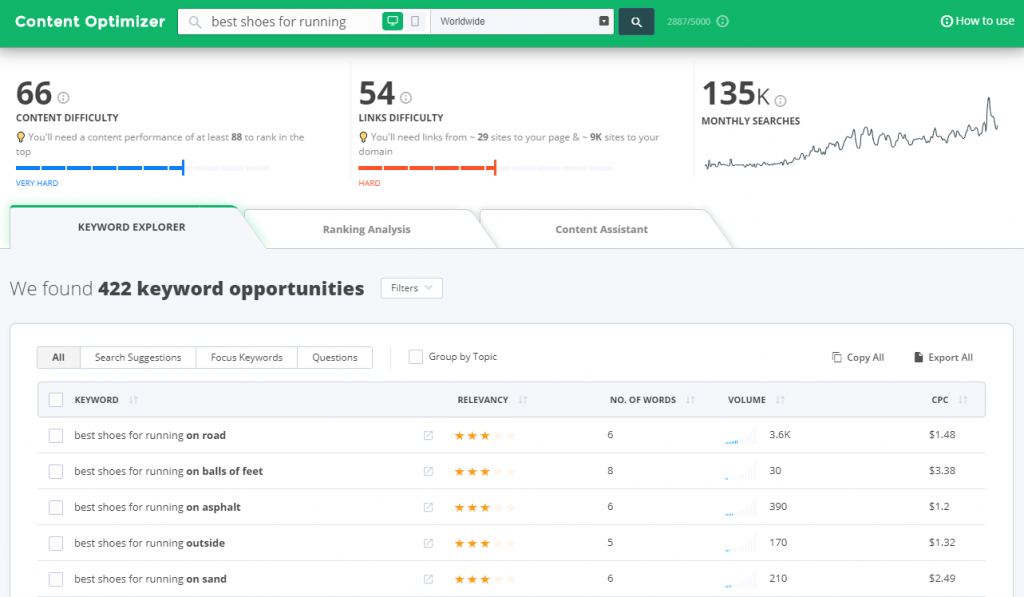

Why any analysis should start with a keyword research?
Because if you don’t know the keywords you want to target, you can’t possibly know your true SEO competition.
This step will also determine what level of difficulty you wish to perform the analysis at.
For example, let’s assume that we’re performing online marketing in the shoe business and wish to open a web store. Depending on our budget, we can either start targeting very high search volume keywords or lower search volume keywords. Keep it realistic.
It either takes money or time to get there. In fact, it takes time in both cases given you’re working with organic search.
| Without a strategy, content is just stuff, and the world has enough stuff. | |
| ARJUN BASU | |
| Award-nominated author | |
The trick with ranking is not to force it. When everybody’s trying to rank for the same keywords, there’s not much room for long-term development. This is where you can improve and find keywords semantically related to your niche, but not necessarily used by your competitors.
Check the Top-of-mind Keywords
Top-of-mind keywords are phrases that pop up in your head right away when you think about a niche. It’s like a brainstorming process. They are also frequently called seed keywords.
You can use the Google search engine to get real-time suggestions. Simply go on Google and start typing your keywords, and new ideas will appear right under the search bar. A highly competitive keyword would be, in this case, “buy shoes online”.
Phrases with the word “buy” in them are called buyer’s keywords or transactional keywords. They are usually the most competitive, as we know from the phrase itself that people are already set to buy the product. Ranking for those keywords practically guarantees that some sales will indeed be made. Where sales are guaranteed, big players come.
A lower competition keyword can be “best shoes for …”.
More niched phrases tend to be less competitive. One reason might be the fact that they are untapped, meaning that not many people actually discovered them. They are called longtail keywords. Review and comparison sites often try to rank here. People are still inclined to buy, but for he moment, they might just be looking to compare products or find ideas.
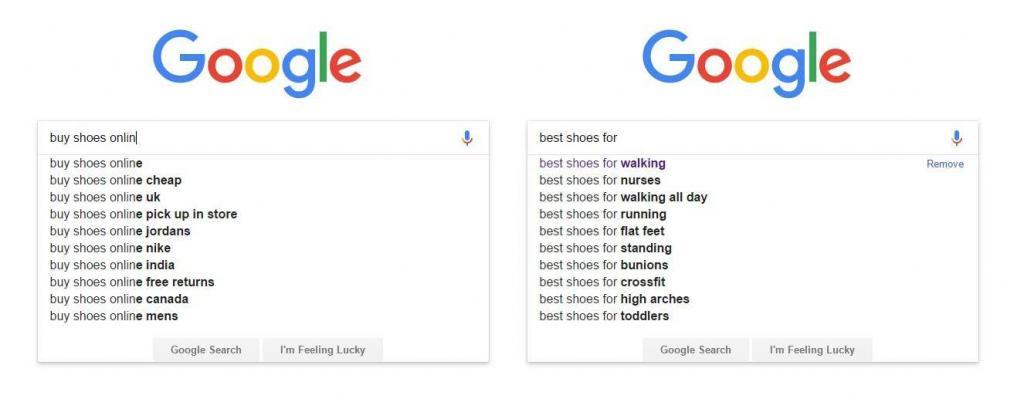

Look for Seed Keywords to the Keyword Explorer or Google Keyword Planner to Get New Ideas
Use the seed keywords you acquired from the previous step to generate a list of keywords.
You can go classic and use the Google Keyword Planner, though data is limited if you don’t have a paying PPC management account.
You can try multiple keywords here, export the data as CSV, sort the keywords, and add some to your list.
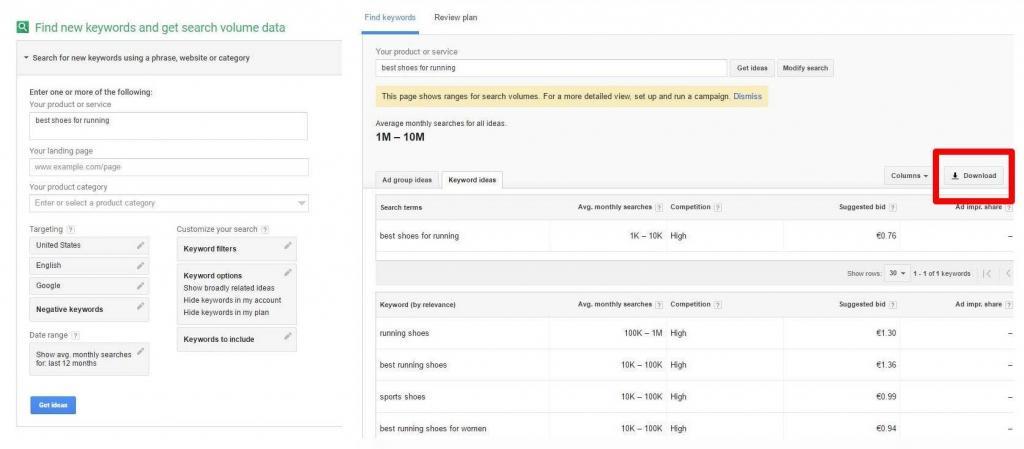

cognitiveSEO’s Keyword Tool can give you tons of keyword opportunities. It works like a content marketing agency that will work on most of your marketing plans, your pieces of content…you got the idea your whole marketing effort in general.
You can check out for questions people are looking for an answer on Google. You can filter the keywords ideas by volume, relevancy and so on, so you can find the best keyword opportunities for you.
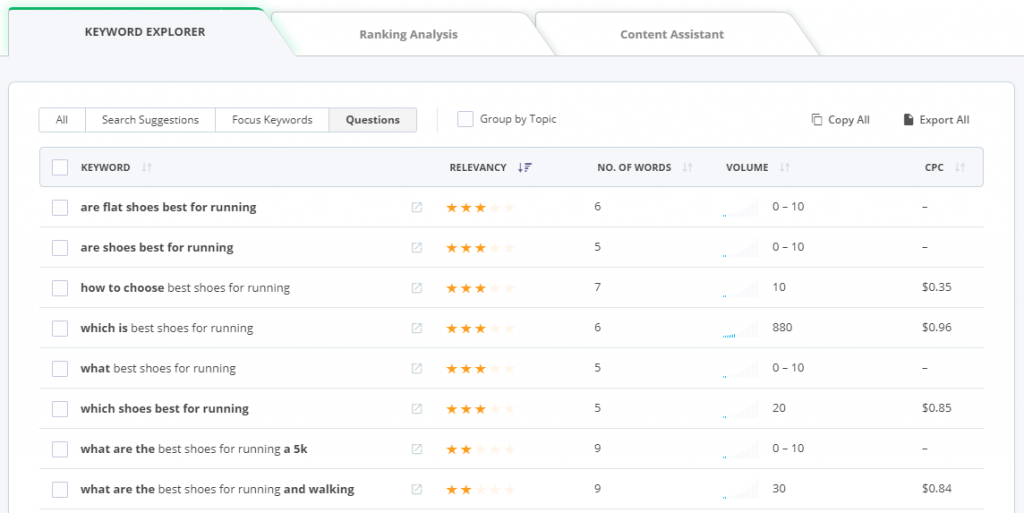

Prioritize the Keywords You Want to Rank For
Now comes the more difficult part.
For which of those keywords can you realistically rank in top Google search?
After you’ve determined a list of keywords you’ll go after, you have to take a look at two things:
Content Performance and Domain Performance.
You can use the Ranking Analysis section of the Content Optimizer Tool.
Let’s take as example the keyword this article is talking about: content marketing services.
You can easily see a lot of important metrics, just one click away:
- how many links would this article need to be competitive?
- what is the monthly search for this keyword and how’s the searching trend for it?
- who is ranking in top 10 and how do their content looks like?
- how old/fresh is the content already ranking?
- what focus keywords did my competitor use within their content?
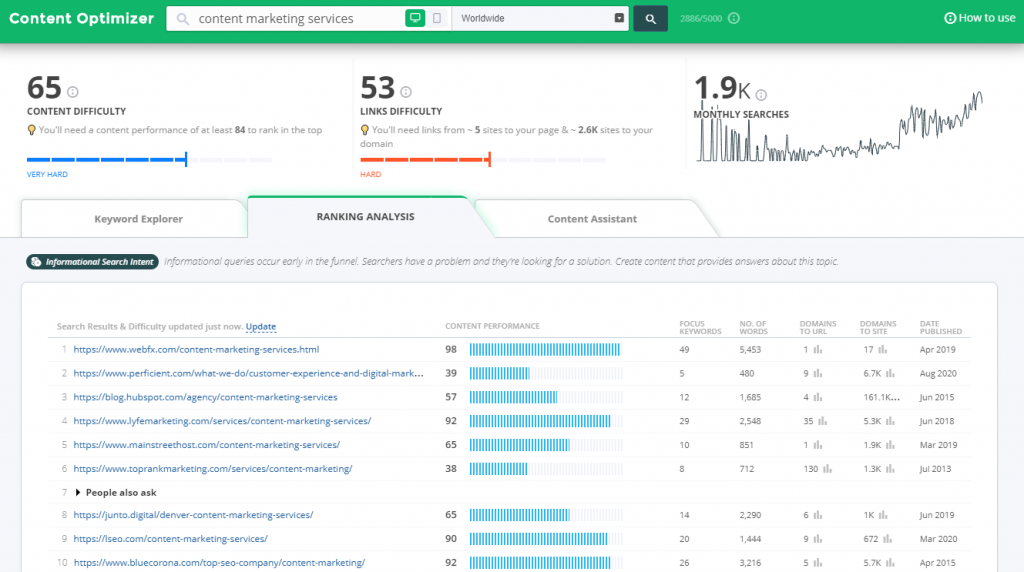
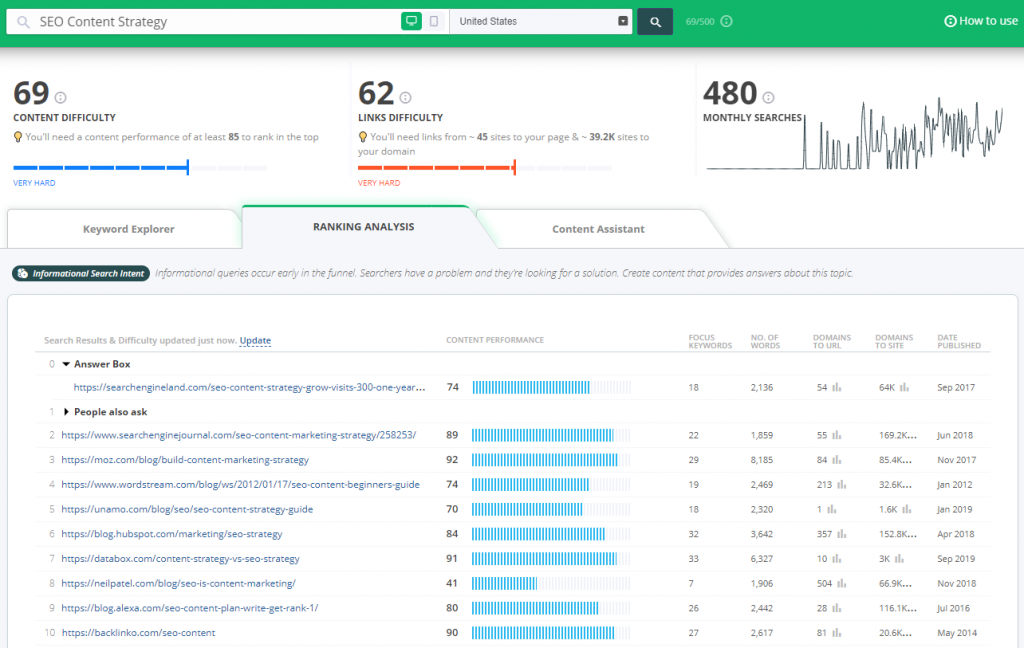
While the Content Performance is something that we have control over and will improve in a future step, backlinks aren’t something we have that much control over.
So, you want to see websites with as few referring domains as possible compared to your site (which you can check with the Site Explorer).
Of course, if you see a lower content score and/or word count, those are also good indicators that it will be easier to create content for or improve existing content.
Select Top Keywords Based on Relevancy and Search Volume
For the purpose of this analysis example, we’ll just stick to these keywords: “buy shoes online” and “best shoes for”. One is broader and the other is narrower, but both are attractive in terms of relevance and search volume. Let’s assume that we start from the bottom (narrower keywords), but leave room for expansion in the future (broader keywords).
From these two keywords, we can observe that the broader ones tend to return root domains as results, while narrower ones return pages from websites. This is a good indication of what our homepage should be targeting, and what we should target with pages.
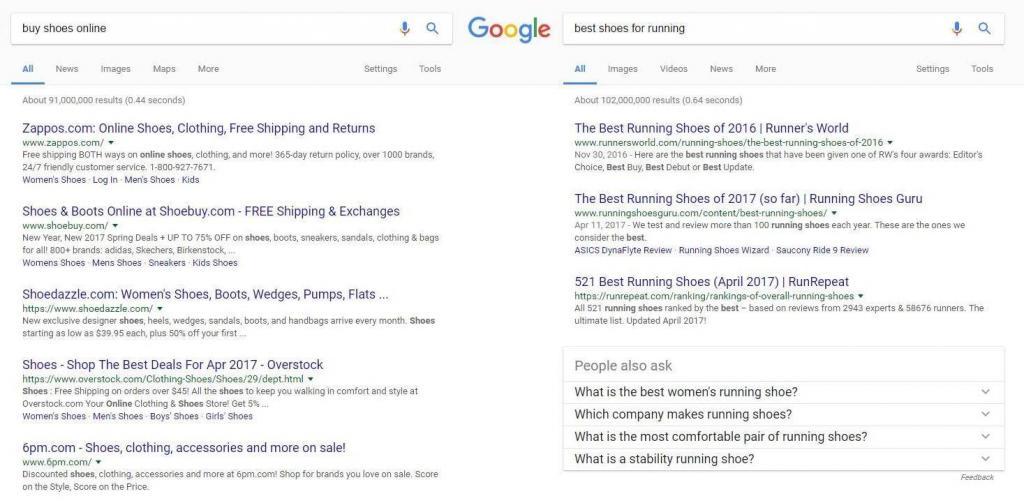

The final list should include keywords around your general niche and some current or possible (future) sub-niches. You can group them into separate sheets. This way you’ll be able to select top competitors from multiple sub-niches easier. The more keywords you’re willing to analyze, the better you’ll understand what you’re dealing with in the long run.
You can use the Google Search Console to easily determine the keyword you’re already ranking for. (the below screenshot is taken in June 2020).
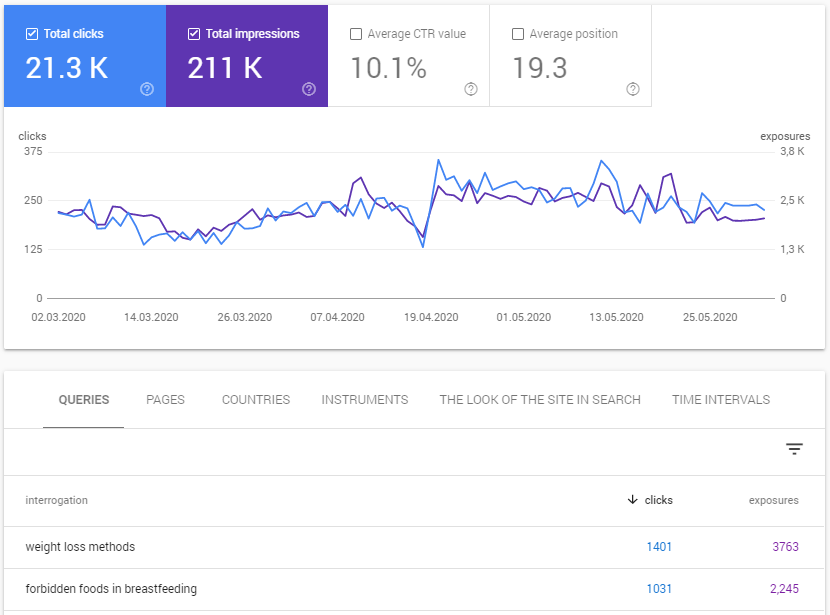

Can you improve this existing content? Or should you target new keywords? These are questions you should ask yourself when putting together your SEO content marketing strategy.
Content Creation
No worries, comparing to the previous section, content creation will feel like a breeze among the content marketing services list.
First, consider that it’s always best to consider landing page optimization for a single main keyword and a single search intent per page.
You can sometimes combine very similar keywords, but try as much as possible to stick to one main keyword and one search intent. Feel free to find out more about search intent here.
A great way to do this is to write content about questions that are very often asked in your industry, or case studies.
For example, this article about meta descriptions affect SEO or not has been linked to multiple times by other SEO blogs trying to make a quick point without getting into too much detail.
Write content that stands out and is share worthy.
While doing so, also make sure to:
- Have great Titles, Headlines and Descriptions.
- Optimize your titles with keywords for SEO, but also keep them catchy for Social Media.
- Use the Open Graph property to set different titles for SEO and Social Media.
Longform content tends to perform better in organic search results. Yet, look at what type of content your competitor have. Is it long, short? What type of content is Google serving within its first page for the type of content you want to rank?
You keep on hearing: write content having readers, but also SEO in mind. But what does this really mean?
We can spend a lot of time on debating that, or we can use a tool that will help us write that exact type of content. As time is so precious these days, I’ll choose the second option.
Open the Content Assistant section from the cognitiveSEO’s content optimizer and hit Start Optimizing.
Once you do so, you’ll get everything you need there:
- the keywords you should use in your content
- the content score you should reach
- keywords ideas to use in your content
- the focus keywords that might help your content with ranking
- the keywords you shouldn’t use that much to avoid stuffing
Basically, you’ll get all the resources you need to write content that is relevant for your users first of all, but also SEO oriented.
The idea is to think of the recommended keywords as subtopics or areas of interest that you should cover in your content.
When people search for something, you already know they are interested in it. That’s why SEM has such a high conversion rate and people spend time reading in-depth articles.
Regardless of the tools you’d be using, keep in mind that the best tool you have at your disposal is your own knowledge.
You should keep in mind that writing naturally is the best way to go.
I know: writing original content regularly might not be easy. Moreover optimized content. Even if you’re a marketing expert that wants to improve brand awareness, an account manager or a search engine optimization, writing with SEO in mind is never easy. There are no perfect marketing guides that will drive results in no time. And copywriting implies extra marketing costs, video content creation costs, maybe website design, content promotion and so on. Yet, when creating your monthly reporting, you’ll check the return on investment and you’ll see that those marketing efforts did pay off. That monthly content and those business goals you struggle with, those SEO audits, they all bring great results.
Content Distribution
The journey shouldn’t stop when the article goes live. On the contrary, you should carry on with the process of boosting your content. You need to understand that content distribution isn’t a single technique or a one-time thing. It incorporates an umbrella of multiple unique techniques you need to follow in order to get better results.
We all had that moment when we gave our soul into a post and made it so shiny, with thorough research, relevant visuals but nobody read it.
And then you start wondering what went wrong. What in the name of God happened? Or why did it happen to you? And the questions could go on.
But there is something that you missed. And that “something” could be content distribution and amplification.
Content distribution is a powerful method to reach a wider audience.
Amplifying your content should be mandatory if you want people to know about it and increase your website traffic.
You can look at the distribution process as a way of strengthening the signals of your post. And here are some channels to do so:
Link Building
If, in the past, the traditional ways of building links meant to meaninglessly spread out all over the internet, without thinking of relevance and essence, through the help of web directories, blogrolls, keyword stuffing and others, now we need to think of our target audience.
Things have changed now, but links are still an important ranking signal and they are very helpful when trying to rank high in the search engines.
It’s a harsh reality but link generating through content marketing will surely become harder and harder.
Yet, harder doesn’t mean impossible. Use blog posts, videos, infographics, eBooks and so on. Create resources that are valuable and that will earn links.
Also, don’t forget about internal linking.
If you’re looking for an SEO move that can quickly boost the position of your website, then internal linking is the move you want to make.
A proper internal linking strategy can really boost your ranking power because it does two things:
#1: It helps search engines understand the structure of your website, how different pages interact with one another and which pages are truly important withing the structure of your website.
#2: It helps users navigate the website and it keeps users on the website by providing relevant content through links that can be followed. This ultimately sends search engines another signal that your website is great, because it provides a good user experience.
If you’re interested in some valuable link building lessons, wrote from experience, check out this article.
Social Media
I know it and you know it. The internet has become so fed up with marketing strategies, that people become immune to content in its mediocre form.
Influencers from all marketing channels are no longer impressed so easily, and in order to put your brand “in their mouth” you need to do some wheel greasing.
So that’s why super important to create content that it’s worth sharing; content that “has something to say”, that brings added value.
Invest in social media marketing as much as you can. Get dedicated account managers or marketing manager if possible. There are many social content marketing companies that are offering good services, just make sure to get the right one to grow your business.
There a lot of tips and tricks on how to perform better on social media. You can consult blogs like BrandMentions‘ one for this.
Promote your content as much as possible but on the right social media channels for your niche.
Use paid media and social media advertising (like Twitter or Facebook advertising) if needed. Make use of partner programs, press releases, custom content, go for influencer marketing if needed.
Yet, it is highly important to make yourself visible on social media. Even if this implies some graphic design activities or video production to steal your potential customers’ attention. Here’s a video production tool you can check it out.
Social media management is as important as writing optimized pieces of content when it comes to building your brand.
Community & Relations
When I think of content marketing, a line from the movie Jerry Maguire comes to mind – Help me, help you!
We’ve seen common outreach methods of content marketing like guest blogging being abused in the past, because people misunderstood the idea behind it.
Generating links through content marketing is not about trying to beg for them, it’s about creating relationships with other businesses and people that reside in the online medium.
You can no longer strive for the number one spot in Google’s eyes if you can’t create new pals that are willing to talk about you and share your content or vice versa.
“Link begging” your way out of a situation will do you more harm than good so we don’t recommend that.
There’s one way out of it and that’s creating content that others might find interesting enough to share it with their audience.
Organic Links are a “hard to get” commodity these days and you’ll be happy to find and keep connections with influencers that like and distribute the content that you create.
In order to help yourself, you need to attend to the needs and interests of others first!
When you can’t create engaging content on your side of the street, try going to the place where the discussion is currently happening.
It may sound like a cheesy tactic but I assure you it’s not a laughing matter. You may include comments in your content marketing strategy as you can generate links and help the community at the same time, in real time.
Comments are a great way to:
- create meaningful content
- connect and engage with your target audience
- create links pointing to your site in a natural manner.
Comments can prove to be a blade with two edges and you need to treat it with care.
Try and find the most important forums in your niche and where the discussions are taking place.
Look at what people are asking and what questions they have.
As long as you stay on topic and your comments are not only meant for link building, then you won’t have nothing to worry about.
Above are just a few content distribution ideas. For even more ideas for amplification, check out this article.
Constant Content Update
What if I were to tell you there’s another way, besides tapping into that creative juice barrel?
Nobody expects you to create original and engaging content all the time.
You just can’t create quality content on an assembly line and everybody knows that, and no, you shouldn’t resort to gimmick techniques to win your target audience’s attention.
What you can do is to recycle outdated content that may still be of interest to your target audience.
Some content has been geniously created in the past and widely distributed, but that doesn’t mean you cannot use that already developed interest to your advantage.
Those infographics that were widely distributed and shared, which created a lot of discussions over the internet can be refurbished using the same layout and the same structure but with fresher and more relevant data.
You can also improve old content by adding more information and thus more value for the viewer.
While this might be appealing for those looking for a shortcut method of generating content, it should be part of a balanced diet.
It seems easily exploitable, but if done improperly, you might end up feeding your site with low quality content.
We’ve done an interested experiment some time ago: We’ve updated 40 blog posts with fresh, updated information.
The result? 70% SEO visibility increase. So, it could be a tactic that could work for you to. You can check out the case study here.
Content Analytics Reporting
You know the saying. No job is done until the paperwork is done.
In our case, not literally paper, but reporting the results. This is an equally important part of the content marketing services list.
So, you’ve created a content marketing strategy; you’ve written awesome content or updated the existing one, you’ve highly distributed.
Now, what’s to do?
Check out the result!
But what should you check?
Measuring content marketing and SEO efforts is often easier said than done.
Yet, here are some metrics you should definitely look at.
Organic Search Traffic
Organic search traffic refers to website visits that originated from search engine results and not through ads. Organic search traffic is a highly effective indicator of overall success. When a website’s content includes keywords that frequently match what users are searching for, that website is likely to appear in a larger number of search engine results pages (SERPs) than competing websites.
Using Google Analytics, open the Acquisition menu. From there, select All Traffic, then select Channels.


You’ll now be presented with a view of a website’s sources of traffic, which are sorted by channel.
Select the Organic Search channel for a useful report that displays a site’s organic traffic stats.
This report is a versatile one. It gives SEO practitioners the ability to uncover critical information such as:
- Which landing pages are the most effective at attracting traffic
- Which keywords are delivering the highest amounts of traffic
- Which of the search engines are directing the highest amount of organic traffic to a website
- What pages are frequently the biggest exit pages (or the last page a visitor views before leaving the website)
- And many other vital stats
Keyword Rankings
Keyword Ranking is how well or how poorly your content ranks in SERPs for a given search term.
Google analytics isn’t as helpful as some SEO practitioners would like it to be as far as tracking keyword rankings.
Its keyword tab (within the campaign tab) often displays the phrase “not provided.”
Instead of Google analytics, consider the rank tracker provided by cognitiveSEO.
One of its advantages is that it allows you to track keywords at a universal level as well as at a local level. It also allows you to analyze the keyword performance of competitors.
So, add your keywords you created content for within the Rank Tracker and constantly check out the evolution.
![]()
Social Shares
Social shares can be defined simply as the sharing of your content by social media users.
While it’s generally thought that Google does not take social signals and shares into consideration when ranking SERP results, social shares are still very important to your SEO efforts.
Tracking your social shares is beneficial because of the important impact social media plays in content marketing strategies.
As more people share your content with their followers, the higher the chances that more people will view it and ultimately migrate over to your website.
More visits to your website means a boost in organic search ranking.
Backlink Volume
Useful for measuring the authority and popularity of your website, backlinks (often referred to as inbound links) are links to your website that originate from someone else’s website.
Backlinks to your site can also originate from other pages on your own site.
Measuring this performance indicator will go a long way in helping you rank higher.
By tracking it, you’ll always know where you stand with what some in the SEO industry view as the most important ranking factor used by Google.
When you know whether you’re succeeding with your backlinks, you know how much you need to improve by.
Using Google Analytics, open the Acquisition menu. From there, select All Traffic, then select Referrals.
You can now look at your referral traffic, which is Google’s way of saying “backlinks.”
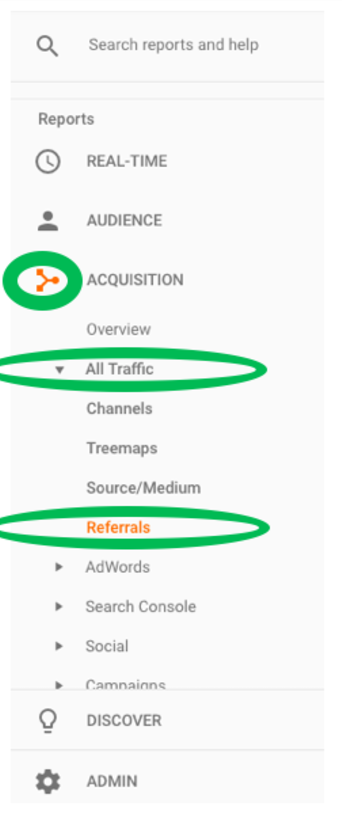

Also, for a comprehensive backlink analysis tool, cognitiveSEO aggregates backlink data from trusted link databases and analyzes the links on demand for each of their clients.
I know, there are a lot of information from the digital marketing area to deal with.
But even if you’re one the one who’ll be implementing all the content marketing services above, even if you’re hiring marketing agencys, it’s important to know what’s all about.
If you or your marketing team are out of breath after reading this post (or worse yet, discouraged,) don’t be overwhelmed!
Take heart, force a smile, and accept the fact that victory never comes easy. I know, lots of things are involved: technical SEO, marketing budget, web design, content calendars or advertising costs. But it does pay off in the attempt of building brand that is strong and competitive.
Success and competitiveness are for those who are willing to work harder and get their hands dirtier.
The bottom line here is that you can do this, and it will be worth it.



